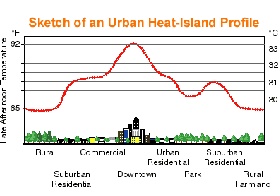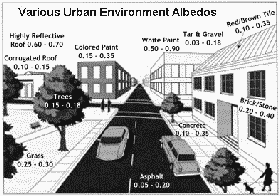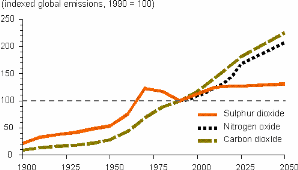 > English > Climate in brief > - Climate in Cities
> English > Climate in brief > - Climate in Cities
Urban heat islandsIn a city, the magnitude of emissions, and additional anthropogenic heat supply is different from that in uninhabited regions. Think about all the homes, heating, lights, industry and vehicles concentrating there. Therefore, the urban climate has to be discussed as a special climate type and we do this in a separate section. Big cities release, on a local scale, much more energy compared to the land around them. Therefore they are called urban heat islands. However, in contrast to former assumptions the majority of scientists do not believe, that big cities cause a strong perturbation of the world's climate.
|
|
|
The contribution of the urban heat island effect to the last century's global temperature increase of 0.4 to 0.8 °C, is estimated to be not more than 0.05°C. In particular, minimum temperatures are higher than in rural areas, leading to a smaller temperature difference between minimum and maximum daily temperature. Although the climate in the cities is not a big factor in the world's heat balance, it is very important to us, because most people live or work in towns and spend many hours of their day in the climate of cities. The conditions and indoor pollution in your room must also be considered!
|
|
|
|
The images above explain the special character of the city climate. Due to heating, production processes, air conditioners and other sources, heat is generated in the city itself. Additionally, major parts of a town's surface absorb more sunlight than an average landscape. The albedo (reflection of sunlight) is low as figure 4 shows. Cities also tend to store this heat, because the natural cooling processes do not work. Vegetation is cooled by evaporation of water, which consumes energy. In cities however, the ground is sealed. Water disappears quickly in the canalisation and the cooling effect is low.
|
Air pollutionIn the urban areas, diverse organic (benzene, solvents, polyaromatic hydrocarbons, ...) and inorganic compounds are emitted. While some of the organic compounds are carcinogenic (cancer causing) and a danger for human health, on the other hand they are not a global burden for nature. Organic emissions are dominated by vegetation. The main problems of urban air pollution, having bigger climate impact, are inorganic emissions:
|
|
|
Acidification and acid rainSulphur dioxide emissions come from industry, primarily power plants (burning of coal for power generation). Nowadays this issue no longer makes the headlines in Europe. Sulphur dioxide emissions drastically decreased due to the economic crisis and lower production in post-communist countries, and also due to modern filter techniques. But the problems are rising in south east Asia. And long-term damage to the forests, caused by the acidification of the soils, has not yet been repaired.
|
|
Acidification of the air and acid rain are the consequences of the atmsopheric sulphur oxidation process leading to the formation of sulphuric acid. Additionally nitric acid is formed from nitrogen oxides. The damage caused by acid rain can be seen in forests but also on buildings and other matter in cities (see images below).
|
|
|
City designIn the past towns grew without caring much about the environment. Nowadays much more is known about the different heat balance, about the water runoff and the disadvantages of sealed areas, as well as about the windflow in cities. If new areas in a modern city are planned, such factors are taken into account. Higher buildings are sometimes tested as a model in a wind tunnel and modern houses can be constructed with energy saving claddings. Such techniques are still expensive but may determine the cities of the future.
|
|
|
Visit the section CLIMATE IN CITIES in our encyclopaedia in order to learn more about air pollution, the special conditions of the urban climate, its energy balance and developments and the dangers of acid rain.
About this page:Author: Dr. Elmar Uherek - MPI for chemistry, Mainz |









